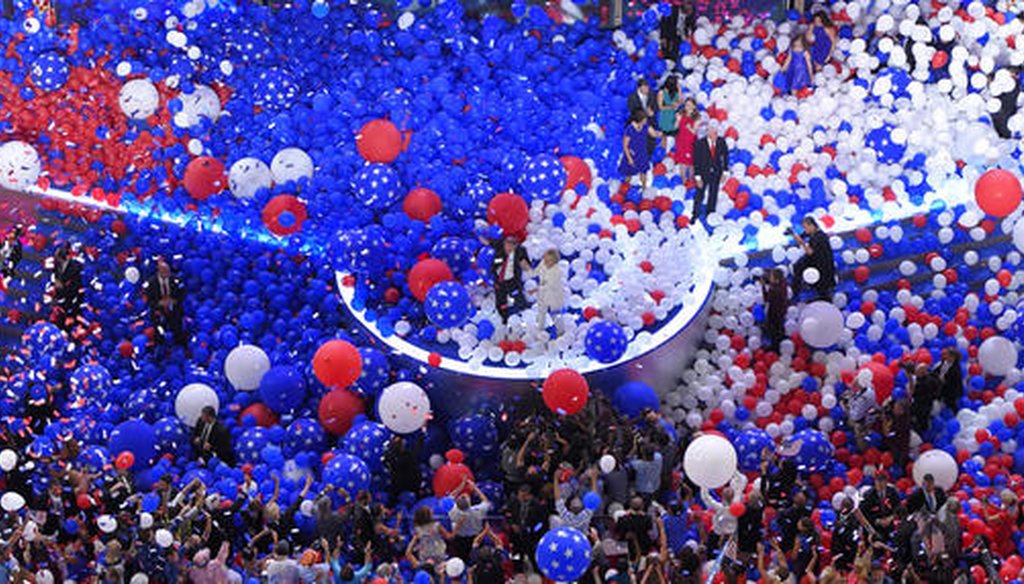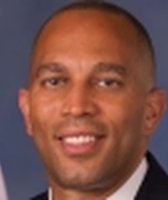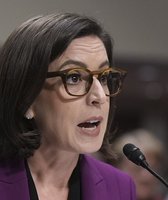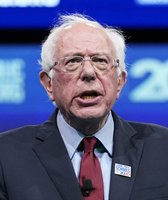Get PolitiFact in your inbox.

Balloons fall during the final day of the Democratic National Convention in Philadelphia on July 29, 2016. (AP)
If Your Time is short
• Political observers wonder whether this summer could bring a “contested” Democratic convention, one where no candidate has the simple majority of delegates required to crown a nominee.
• If no candidate has a majority of pledged delegates, and if no agreement is reached among the candidates, the convention vote would go to a second ballot, which is unprecedented in the modern era. At that point an additional batch of party regulars known as superdelegates can vote — possibly for someone other than the delegate leader.
On the eve of the South Carolina primary — the fourth contest in the 2020 Democratic nominating calendar — fewer than 3% of delegates had been distributed to candidates. But that didn’t stop rampant speculation about a contested Democratic convention in July — one in which the nominee isn’t known ahead of time because no candidate has a clear majority of delegates’ votes.
This possibility reached the debate stage in Las Vegas before the Nevada caucuses, when moderator Chuck Todd asked the six candidates, "There’s a very good chance none of you are going to have enough delegates to the Democratic National Convention to clinch this nomination. Should the person with the most delegates at the end of this primary season be the nominee, even if they are short of a majority?"
Only one candidate, Sen. Bernie Sanders, I-Vt., said yes.
Not surprising, since he’s got a big lead. In Iowa, New Hampshire and Nevada, Sanders accumulated 45 delegates — a little under half of the delegates awarded to that point. The other candidates who had secured delegates are Pete Buttigieg (25), Joe Biden (15), Elizabeth Warren (8) and Amy Klobuchar (7). Other candidates still in the race, such as Tom Steyer and Tulsi Gabbard, have failed to secure any delegates, while Mike Bloomberg wasn’t on the ballot in any of the states that have had contests to this point.
While the specter of a contested convention has been raised before — most recently during the heated 2008 nomination fight between Barack Obama and Hillary Clinton — an actual one would represent a sharp break with decades of political history, and it would pose a risk for the Democratic nominee’s chances of winning the presidency in 2020. That’s because a contested convention would put factional divisions on display to the nation’s voters this summer and force the party to unify just months before the November election.
Sign up for PolitiFact texts
How the nomination process will play out at the convention — not to mention who the nominee will be — remains to be seen. But political observers say there’s a real chance of a contested convention in 2020, given the large number of candidates and the depth of the divisions between wings of the Democratic Party.
How does the Democrats’ delegate system work? We asked experts to explain the process and produced the following Q&A. The answers address the Democratic rules as we know them today; the Republican delegate system is similar but has some important differences. (It’s also essentially moot this year, since the Republicans have an incumbent president who’s running again.)
How do the Democratic candidates collect delegates?
Any candidate who receives at least 15% of the vote in a given state’s primary or caucuses, either statewide or at the congressional district level, will receive delegates. The others get nothing. The delegates are distributed proportionally among those who reach the 15% threshold, based on the number of votes they received. So anyone over 15% effectively gets a "bonus" allocation beyond the percentage of the popular vote that they received.
In any given state, roughly two-thirds of the delegates are allocated from specific congressional districts. The other one-third are allocated on a statewide basis. This offers delegate-collection opportunities for candidates who are stronger in one part of the state, or among certain types of voters, than they are in the state as a whole.
This allocation process doesn’t include "superdelegates" — more on them later.
How are people chosen to fill these delegate slots?
In some cases, delegates are chosen directly by voters when they cast their ballot. More commonly, they are chosen after the voting is over, usually through congressional-district-level caucuses, state conventions, or state-level meetings attended by members of the party’s central committee. Many of the delegates are selected this way between March and June of the election year.
While the candidates’ campaigns don’t get a free hand in selecting their delegates, they usually monitor the selection process closely. And importantly, the candidate has an official right to review the delegate during a window of time after the selection, which makes it hard for a candidate to be stuck with a delegate who won’t be loyal to them.
Why are people saying that Bernie Sanders is favored to collect the most delegates?
If several candidates remain in the race but fall short of the 15% threshold, that enlarges the delegate haul for the candidates above the 15% threshold. As the winner of the New Hampshire primary and the Nevada caucuses, and a close second in the Iowa caucuses, Sanders has already benefited disproportionately in delegate allotments. In Iowa, Sanders won 26% of the vote but got 30% of the delegates; in New Hampshire, he won 26% of the vote but got 38% of the delegates; and in Nevada, he won 47% of the vote but secured 67% of the delegates.
A candidate with a solid base of supporters, like Sanders, is well positioned to collect some delegates in almost every contest. Until the field narrows, meanwhile, the anti-Sanders vote will be splintered. The longer this splintering continues, the easier it is for Sanders to build his delegate lead.
Does the one with the most delegates get the nomination?
Not unless they have a clean majority. A plurality isn’t enough.
The rules say that to win on the first ballot at the Democratic National Convention — which will be held in July in Milwaukee — a candidate must secure a majority of the 3,979 pledged delegate votes, or 1,991 due to rounding.
Sanders can make the argument that a plurality winner should be given the nomination, but he would have to persuade a majority of delegates to agree.
Do delegates have to vote for the candidates they are "pledged" to?
There’s a presumption that delegates will vote for their candidate on the first ballot, and any attempt to get around that would surely cause fighting at the convention — an event that in recent decades has served as a carefully choreographed coronation, rather than a live selection process.
Still, the ties that bind candidates and delegates on the first ballot are less ironclad than is commonly believed, said Josh Putnam, a political science Ph.D. who specializes in delegate selection rules.
"There is language in the rules that delegates, to the best of their abilities, should vote for the candidate they are pledged to," Putnam said. "And with the right of review, delegates tend to be loyal to their candidate. But it hasn’t been tested in the modern era. Technically, any pledged delegate can vote for anyone they want to."
Even these rules aren’t immune from being changed, Putnam said.
The first official acts of a convention, usually the weekend before it starts, are to finalize and approve the rules governing the convention for a vote of the delegates. One party faction — either an insurgent faction or the party establishment — could draw up an alternate rules package for consideration through a minority report. Whatever package passes the convention will define the rules — and it could have different elements than what we know today.
Can candidates release their delegates to vote for someone else in the first round?
There is some precedent for this. In 2008, John Edwards, who had dropped out in February after collecting some delegates, endorsed Barack Obama in May. Most, though not all, of the Edwards delegates had already decided to jump to Obama — who was leading in the delegate count — even before Edwards made his call to switch their vote.That endorsement came late in the primary process.
But what if a candidate were to drop out after the March 3 Super Tuesday primaries — the biggest delegate-allocation day of the primary season — and tell their delegates to endorse someone else who’s still in the race? This is a more complicated scenario, because while the candidate will have received a delegate allocation, many or all of the individuals filling those delegate slots won’t have been chosen yet.
To make sure these delegates are amenable to the candidate’s wishes, the candidate would have to remain engaged in delegate-selection processes at a time when they are no longer actively running. It’s not an impossible task, Putnam said, but it’s challenging. Another problem, he said, is that some statewide delegate selections are automatically reallocated from candidates who dropped out to those who remain in the race.
This complicates any potential "Stop Bernie" movement that joins together the remaining candidates who are more moderate. On one hand, the best way to assure that you have leverage over your own delegates is to stay in the race as long as possible. On the other hand, remaining in the race means that Sanders’ rivals continue to fragment the anti-Sanders vote in a way that helps him.
"It might be better to drop out and endorse someone, because that would itself influence the voting and the eventual allocation of delegates," Putnam said.
What happens if no candidate gets a majority in the first round?
Whatever force a delegate’s "pledge" to support a specific candidate had in the first round would be harder to maintain in the second. If the convention goes to a second ballot (or beyond), "keeping those delegates on the same page as the candidate in a contested environment would be easier said than done," Putnam said.
Something else important happens in the second round: Superdelegates get to vote.
What is a "superdelegate"?
Superdelegates are a group of elected Democrats from Congress and the states, along with Democratic National Committee members and party elders such as former presidents and vice presidents. Superdelegates are free agents, not bound to any candidate.
Prior to this year, superdelegates were able to vote in the first round at the convention. But an agreement between the Hillary Clinton and Sanders campaigns in 2016 led to a process that eventually changed their status. Under the rules eventually adopted, superdelegates were prevented from voting until the second ballot or later.
This year, there are 771 superdelegates, and on the second ballot, their total would get added to the existing number of delegates to determine the majority needed to win the nomination. This means the new majority threshold to win on a second ballot would be 2,375.
Emory University political scientist Alan Abramowitz said he’s skeptical that a convention could go beyond the first ballot.
"if a candidate, presumably Sanders, is pretty close to having a majority at the end of the primaries or has a big lead in delegates over the second-place candidate, they will likely pick up enough additional delegates from candidates who have dropped out to secure the nomination on the first ballot," he said. "Denying the nomination to a candidate who has a substantial delegate lead would be highly divisive and probably do substantial damage to the candidate who wins the nomination."
However, the New York Times reported on Feb. 27 that it had interviewed 93 superdelegates and found "overwhelming opposition" to making Sanders the nominee if he had a plurality, rather than a majority, of delegate votes.
"This is where you get into uncharted waters," Putnam said. "We have not gone through this" since the modern primary system came into being, "where you don’t have party brokers like you once had. It would be a much more chaotic free-for-all."
Our Sources
New York Times, "How to Win the Democratic Nomination, and Why It Could Get Complicated," Feb. 22, 2020
NPR, "How Many Delegates Do The 2020 Democratic Presidential Candidates Have?" accessed Feb. 26, 2020
Washington Post, "Are Bernie Sanders’s opponents aiming for a contested convention?" Feb. 20, 2020
New York Times, "Democratic Leaders Willing to Risk Party Damage to Stop Bernie Sanders," Feb. 27, 2020
Email interview with Alan Abramowitz, Emory University political scientist, Feb. 27, 2020
Email interview with Kyle Saunders, Colorado State University political scientist, Feb. 26, 2020
Interview with Josh Putnam, political science PhD who specializes in studying delegate selection rules, Feb. 25, 2020




































